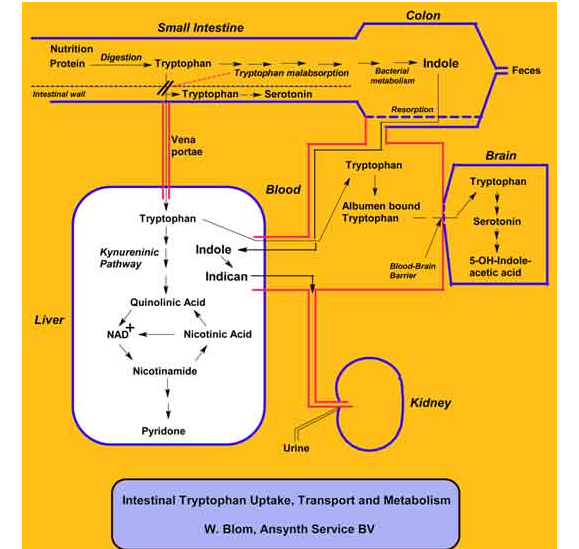Indole Analys
Tryptophan analysis in physiological samples
Tryptophan as essential amino acid needs to be liberated in the small intestine by protein and peptide digestion. Then tryptophan has to be resorbed in the small intestine. A small part of the tryptophan is converted in the wall of the small intestine into serotonin, which is regulating the peristaltic movement of the intestine. Serotonin leaking from the intestinal wall to the blood is absorbed by blood platelets. After the intestinal resorption tryptophan is transported by the vena portae to the liver. See Figure 1. In blood tryptophan is the only amino acid partly bound to albumin. About 15% of tryptophan is free and about 85% is albumin bound. Free tryptophan is needed for protein biosynthesis. In the liver tryptophan has to be metabolized via the kynurenine pathway into NAD+ (Nicotinamide-Dinucleotide). NAD+ is important for e.g. catabolism of Carbohydrates, Lipids and Proteins by oxidative processes, and is then converted into NADH + H+. The respiratory chain regenerates NAD+ from NADH while producing ATP. In rest, a human being uses about 40 kg of ATP/24 hrs for energy required for e.g. muscle contraction, active ion transport and thermogenesis.

After transport of tryptophan over the blood/brain barrier tryptophan is converted into serotonin in the central neural system. Serotonin is a very important neurotransmitter in the central nervous system. The break-down product of serotonin is 5-hydroxy-indoleacetic acid.
Tryptophan not resorbed in the small intestine is partly metabolized by bacteria in the colon. These intestinal metabolites are passively absorbed over the colonic wall and transported directly into the great blood circulation. These metabolites can be metabolized, e.g. in the liver. Finally tryptophan and all tryptophan metabolic and degradation products might be excreted in the urine by the kidney.
Ansynth Service B.V. can estimate free and total tryptophan in blood, and tryptophan, kynurenine pathway metabolites and many indole tryptophan metabolites and degradation products in urine.